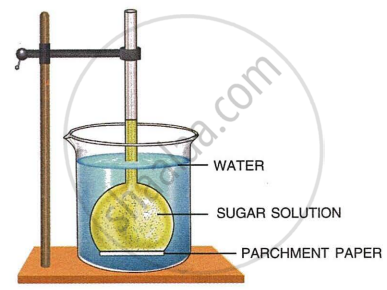Advertisements
Advertisements
प्रश्न
Given below is the figure of an experimental set up to demonstrate root pressure.
(i) Define root pressure.
(ii) What change would you observe in the water level after some time?
(iii) What role is being played by the root pressure in the given experiment?
(iv) Why the oil has been sprinkled on water?
उत्तर
(i) The collective force exerted by the cortical cells of the root in forcing water upward into the xylem is known as root pressure.
(ii) The water level will rise in the glass tube.
(iii) Root pressure is forcing the water up in the stem.
(iv) To prevent evaporation of water from the tube.
APPEARS IN
संबंधित प्रश्न
A candidate in order to study the process of osmosis has taken 3 potato cubes and put them in 3 different beakers containing 3 different solutions. After 24 hours, in the first beaker the potato cube increased in size, in the second beaker the potato cube decreased in size and in the third beaker there was no change in the size of the potato cube. The following diagram shows the result of the same experiment:

(i) Give the technical terms of the solutions used in beakers, 1, 2 and 3.
(ii) In beaker 3, the size of the potato cube remains the same. Explain the reason in brief.
(iii) Write the specific feature of the cell sap of root hairs which helps in absorption of water.
(iv) What is osmosis?
(v) How does a cell wall and a cell membrane differ in their permeability?
Give the equivalent terms for the following:
Pressure of the cell contents on the cell wall
Differentiate between the following:
Plasmolysis and deplasmolysis
Leaves of the sensitive plant wilt and droop down on a slight touch. What mechanism brings about this change?
The diagram given below represents an experimental set-up to demonstrate a certain process. Study the same and answer the questions that follow:

- Name the process.
- Define the above-named process.
- What would you observe in the experimental set-up after an hour or so?
- What control experiment can be set up for comparison?
- Keeping in mind the root hair, cell and its surroundings, name the parts that correspond to
- concentrated sugar solution
- parchment paper
- water in the beaker
- Name any other material that can be used instead of parchment paper in the above experiment.
- Mention two advantages of the process for the plants.
Show by a series of diagrams, the change which a plant cell will undergo when placed in
Hypotonic salt solution
Distinguish between the following:
Turgor pressure and osmotic pressure
Give Reasons for the following.
We gargle with saline water in case of throat infection.
Fill in the Blank
The pressure which develops in the cortical cells of root which force a part of the water upward ____________.
DPD of a cell can be expressed as ______
